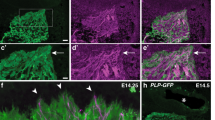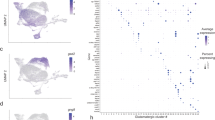Abstract
In embryonic nervous systems, growing axons must often travel long distances through diverse extracellular terrains to reach their postsynaptic partners. In most embryos, axons grow to their appropriate targets along particular tracts or nerves, as though they were following guidance cues confined to specific pathways1–3. For example, in all vertebrates, axons from the retina invariably grow to the tectum along the well-defined optic tract4–6. Yet, transplant experiments demonstrate that retinal axons make tectal projections even though they enter the brain at locations which are distinctly off the optic tract7–11. Only recently has it become possible to label discreet growing projections in the embryonic vertebrate brain12. Thus, it is not yet known whether displaced retinal axons grow directly towards the tectum or find it accidently, through random extension. To resolve this question, pioneering axons from normal and transplanted eyes in embryonic Xenopus were labelled using a short-survival horseradish peroxidase (HRP) method4, and their orientation during growth was quantitatively assessed. The finding that the ectopic fibres head towards their distant targets implies that guidance cues are not restricted to specific pathways but are distributed throughout the embryonic brain. The significance of this result is discussed with respect to the ontogeny and evolution of the visual pathway.
This is a preview of subscription content, access via your institution
Access options
Subscribe to this journal
Receive 51 print issues and online access
$199.00 per year
only $3.90 per issue
Buy this article
- Purchase on Springer Link
- Instant access to full article PDF
Prices may be subject to local taxes which are calculated during checkout
Similar content being viewed by others
References
Singer, M., Norlander, R. H. & Egar, M. J. comp. Neurol. 185, 1–22 (1979).
Goodman, C. S. Bioscience 34, 300–306 (1984).
Lance-Jones, C. & Landmesser, L. Proc. R, Soc. B214, 1–18 (1981).
Harris, W. A., Holt, C. E., Smith, T. A. & Gallenson, N. J. Neurosci. Res. 13, 101–122 (1985).
Shatz, C. J. & Kliot, M. Nature 300, 525–529 (1982).
Thanos, S. & Bonhoeffer, F. J. comp. Neurol. 219, 420–430 (1983).
Hibbard, E. Expl. Neurol. 19, 350–356 (1967).
Sharma, S. C. Nature new Biol. 238, 286–287 (1972).
Hibbard, E. & Ornberg, R. L. Expl. Neurol. 50, 113–123 (1976).
Constantine-Paton, M. & Capranica, R. R. J. comp. Neurol. 170, 17–32 (1976).
Harris, W. A. J. Neurosci. 2, 329–353 (1982).
Holt, C. E. & Harris, W. A. Nature 301, 150–152 (1983).
Nieuwkoop, P. D. & Faber, J. Normal Tables of Xenopus laevis (North-Holland, Amsterdam, 1956).
Rugh, R. Experimental Embryology (Burgess Publishing Co., Minneapolis, 1962).
Holt, C. E. J. Neurosci. 4, 1130–1152 (1984).
Ferguson, B. A. Soc. Neurosci. Abstr. 9, 759 (1983).
Harris, W. A. J. comp. Neurol. 194, 319–333 (1980).
Constantine-Paton, M. & Capranica, R. R. J. comp. Neurol. 170, 17–32 (1976).
Sladek, J. R. & Gash, D. M. Neural Transplants: Development and Function (Plenum, New York, 1984).
Gunderson, R. W. & Barrett, J. N. J. Cell Biol. 87, 546–554 (1980).
Lumsden, A. G. S. & Davis, A. M. Nature 306, 786–788 (1983).
Carri, N. A. & Ebendal, T. Dev. Brain Res. 6, 219–229 (1983).
Nurcombe, V. & Bennett, M. R. Expl. Brain Res. 44, 249–258 (1981).
Sarthy, P. V., Curtis, B. M. & Catteral, W. A. J. Neurosci. 3, 2532–2544 (1983).
Gierer, A. Biol. Cybern. 42, 69–78 (1981).
Bonhoeffer, F. & Huf, J. EMBO J. 1, 427–431 (1982).
Author information
Authors and Affiliations
Rights and permissions
About this article
Cite this article
Harris, W. Homing behaviour of axons in the embryonic vertebrate brain. Nature 320, 266–269 (1986). https://doi.org/10.1038/320266a0
Received:
Accepted:
Issue Date:
DOI: https://doi.org/10.1038/320266a0
This article is cited by
-
On the current state of altruism: generosity in the eyes of natural selection from Darwin to today
RENDICONTI LINCEI (2009)
-
The cell biology of neuronal navigation
Nature Cell Biology (2001)
-
Formation of target-specific neuronal projections in organotypic slice cultures from rat visual cortex
Nature (1990)
Comments
By submitting a comment you agree to abide by our Terms and Community Guidelines. If you find something abusive or that does not comply with our terms or guidelines please flag it as inappropriate.



